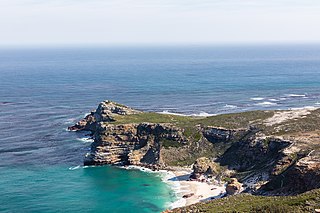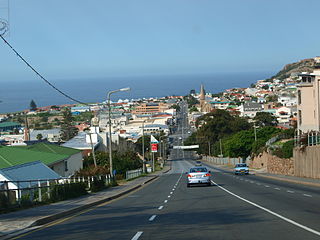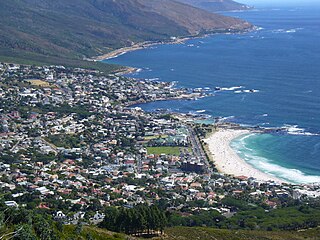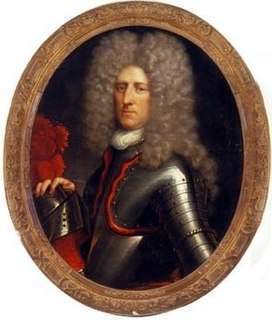Related Research Articles

Cape Town is the second most populous city in South Africa after Johannesburg and also the legislative capital of South Africa. Colloquially named the Mother City, it is the largest city of the Western Cape province and forms part of the City of Cape Town metropolitan municipality. The Parliament of South Africa is situated in Cape Town. The other two capitals are located in Gauteng and in the Free State. The city is known for its harbour, for its natural setting in the Cape Floristic Region, and for landmarks such as Table Mountain and Cape Point. Cape Town is home to 64% of the Western Cape's population. The city was named the World Design Capital for 2014 by the International Council of Societies of Industrial Design.

The Cape of Good Hope is a rocky headland on the Atlantic coast of the Cape Peninsula in South Africa.

Johan Anthoniszoon "Jan" van Riebeeck was a Dutch navigator and colonial administrator who arrived in Cape Town in what then became the Dutch Cape Colony of the Dutch East India Company.

Mossel Bay is a harbour town of about 99,319 people on the Southern Cape of South Africa. It is in an important tourism and farming region of the Western Cape Province. Mossel Bay lies 400 kilometres east of the country's seat of parliament, Cape Town, and 400 km west of Port Elizabeth, the largest city in the Eastern Cape Province. The older parts of the city occupy the north-facing side of the Cape St Blaize Peninsula, whilst the newer suburbs straddle the Peninsula and have spread eastwards along the sandy shore of the Bay.

Antoine Raymond Joseph de Bruni, chevalier d'Entrecasteaux was a French naval officer, explorer and colonial governor. He is perhaps best known for his exploration of the Australian coast in 1792, while searching for the La Pérouse expedition. Antoine Bruni d'Entrecasteaux is commonly referred to simply as Bruni d'Entrecasteaux or Bruny d'Entrecasteaux, which is a compound surname.
The following lists events that happened during the 1740s in South Africa.

Camps Bay is an affluent suburb of Cape Town, South Africa, and the small bay on the west coast of the Cape Peninsula after which it is named. In summer it attracts many South African and foreign visitors.
The following lists events that happened during the 1730s in South Africa.
The following lists events that happened during 1882 in South Africa.
The following lists events that happened during the 1680s in South Africa.
The following lists events that happened during 1862 in South Africa.

Pieter de Carpentier was a Dutch administrator of the Dutch East India Company (VOC) who served as Governor-General there from 1623 to 1627. The Gulf of Carpentaria in northern Australia is named after him.
António de Saldanha was a Castilian-Portuguese 16th-century captain. He was the first European to set anchor in what is now called Table Bay, South Africa, and made the first recorded ascent of Table Mountain.
Krige is an Afrikaner surname that probably means "warrior" or "soldier". The oldest document where this family name appears is a church register dated April 1400. The register shows the yearly contribution that the “Kryghe-hus” made to the church. In later church documents the name mostly appear as Kriege, but variations like Krige, Krigee and Crigee is also found.

Maurits Pasques de Chavonnes was governor of the Dutch Cape Colony from 1714 till 1721.

Stellenberg is a suburb in Bellville, Western Cape South Africa.
Before dawn on 20 November 1722, the Dutch East Indiaman Schoonenberg, on its return journey from Batavia to the Netherlands, foundered on a reef at Struis Bay. Exceptionally comprehensive documentation regarding this event has been preserved in the Cape archives: the relevant Resolutions of the Political Council and correspondence between the Cape Governor and the Council of XVII in the Netherlands; the Ship's Journal of the skipper; travel journals of the missions to the wreck; affidavits by the ship's officers and men; the charge-sheet of the fiscal; the documentation of the judicial enquiry by the Council of Justice, with several rounds of arguments and counter arguments, and the final verdict. This allows the events, as they unfolded 300 years ago, to be reconstructed in detail. Nevertheless, it was a fable, deviating radically from the truth, which caused the Schoonenberg disaster to become well known.
Olof Godlieb de Wet (1739-1811) was a South African high-ranking official in the Dutch East India Company and co-founder of the Freemasons in South Africa.
Pieter Gysbert Noodt was governor of the Cape of Good Hope from 1727 to 1729. He was first employed by the United East India Company as director of fortifications in India, and visited the Cape of Good Hope for the first time in 1718, where he remained for nearly a year. He was a combative character, but it was not until his return to the Cape in 1727 as governor that it became clear exactly how unfit he was for office. He has explored some forests in the interior, but his name is mainly associated with the barbaric treatment of a number of soldiers, driven to obscurity by his actions.
Jan de la Fontaine was governor of the Cape from 1729 to 1737, after also acting as governor in 1724 to 1727.
References
See Years in South Africa for list of References